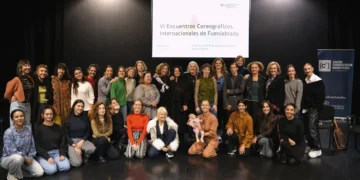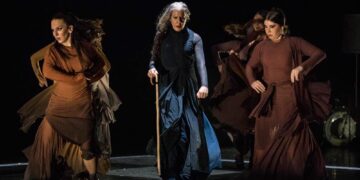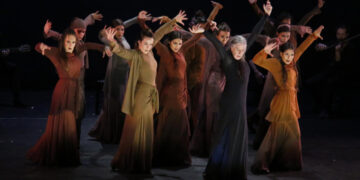 16th Festival de Jerez 2012 16th Festival de Jerez 2012
María Pagés “Utopía”
|
|
Text: Estela Zatania DANGEROUS CURVES Dance: María Pagés, Isabel Rodríguez, Eva Varela, María Vega, José Antonio Jurado, Paco Berbel, Rubén Puertas. Cante: Ana Ramón, Juan de Mairena. Guitar: Rubén Levaniegos, José “Fyty” Carrillo. Voice, guitar and cavaquinho: Fred Martins. Cello: Sergio Menem. Percussion:Chema Uriarte. Farruca choreography and choreographic assistant: José Barrios. Staging and wardrobe design: María Pagés. María Pagés’ shows have always been somehow…different, although one way or another, they are entertaining, imaginative and original. So let’s look at what happened last night with her new work “Utopía”.
The Seville dancer’s greatest virtue is her theater savvy, her capacity to move people and objects around a stage to tell stories, nearly always in a straightforward and uncomplicated way, a sort of flamenco Disneyland. It’s an attractive package which, whether they admit it or not, is appealing to even the most diehard flamenco fan, the kind of person who has a hard time decoding the brainy conceptual shows proposed by other artists. The lady knows the importance of having a presentation number. Years ago it was a constant in every show, that is, a group dance, short, upbeat and with little complication, to focus people’s attention and pave the way for more substantial pieces. Over the last couple of decades this practice has been seen much less, but a work without a presentation number has less impact and coherence. The program, indicating there would be eight scenes, confirmed María Pagés intent in this respect: “Scene one: Utopía. A prologue, an index of what is about to follow, a presentation of the characters, symbols and motifs”. Precisely. The scenes follow with the farruca of Pagés dressed in a form-fitting black body suit to the music of a mournful cello with a somewhat flat choreography. The scene of trilla and soleá apolá (this year trilla cantes have been featured a lot in the Festival), with verses from illustrious poets such as Neruda and Cervantes, in addition to those of the guitarist, wisely and effectively makes use of the darkness which in other works has simply been the absence of light. It’s at this point you notice the ingenious floating set decoration: three long flexible poles cross the stage horizontally, supported from above in different ways so as to suggest waves, mountains, arches, rolling hills or what have you, depending on the needs of each scene. It’s pure Pagés, and it works. Granaína and abandolao, and the flexibility of the melodies seems to be echoed in the curving movements of Pagés whose dancing would be more flamenco with less embellishment, more understatement, but it’s clear this is not her objective. Even the hanging set decoration is curvy. Siguiriyas compás at full throttle sets the scene for martinete and debla with the sweet voice of Ana Ramón. A guajira with three women with fans becomes a solo dance by María. I’d have to read the lengthy libretto to explain the reason for including the Brazilian singer-musician Fred Martins, but let it suffice to recall that María Pagés has often included music and musicians from other latitudes. On this occasion it added little, but wasn’t necessarily annoying. Alegrías de Córdoba, María in bata de cola, curves and more curves, arms like pasta al dente, it’s a rococo concept which is difficult to assimilate. As difficult as the words on the program that refer to this scene: “The end of the journey. The breaking of chains. The joy of ascending to a place where we, so small, observe from the cosmos”. I also took a peek at the libretto which tries to explain why the dancers’ costumes are grey and unattractive, but I refuse to accept or cite it because a work of music and dance must be able to stand alone without verbal explanations. What it comes down to, you take away the visual opulence of Pagés’ creations, and it’s a bit like finding out that the magician behind the curtain has more fantasy than magic. “Utopía” is a slow work that ends not with a bang but a whimper, and the audience’s reaction was more tepid than warm…not even diehard fans seemed to be convinced. At midnight at the Fernando Terremoto peña, the group of Luis de Pacote with Rosario Heredia and Antoñito Malena performed, and tomorrow, Saturday is the closing night of the 2012 Festival de Jerez featuring Joaquín Grilo.
|
Descubre más desde Revista DeFlamenco.com
Suscríbete y recibe las últimas entradas en tu correo electrónico.


 The famous saying that makes fun of my profession is: “Writing about music is like dancing about architecture”. And dancing about architecture, namely that of Oscar Niemeyer, is precisely what María Pagés aims to do in this show.
The famous saying that makes fun of my profession is: “Writing about music is like dancing about architecture”. And dancing about architecture, namely that of Oscar Niemeyer, is precisely what María Pagés aims to do in this show.






















